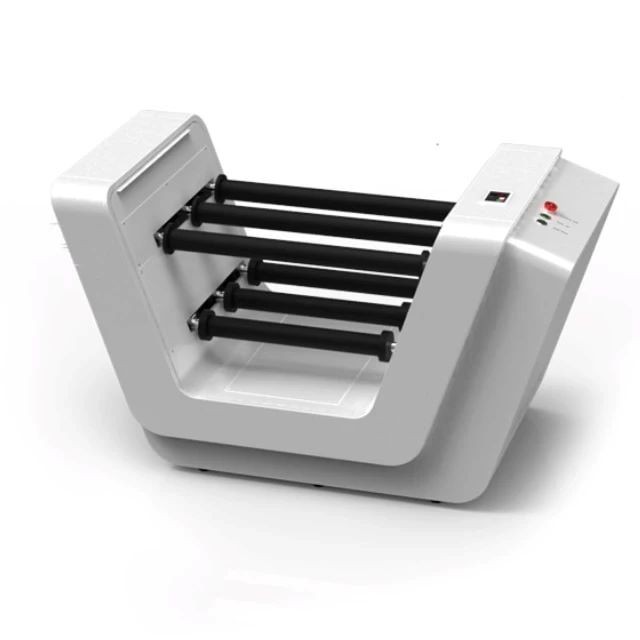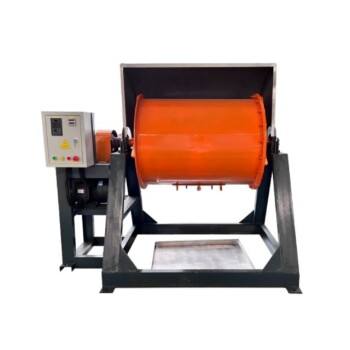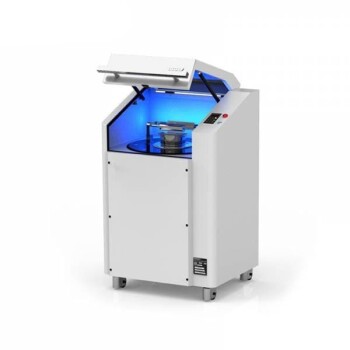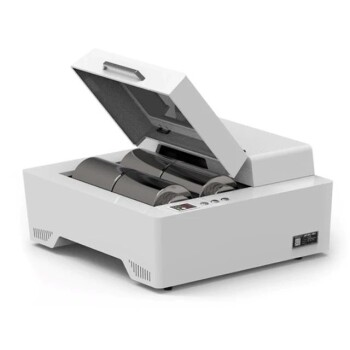
Milling Equipment
Laboratory Ten-Body Horizontal Jar Mill for Lab Use
Item Number : KT-HJM10
Price varies based on specs and customizations
- Maximum injection size
- < 5 mm
- Sample particle size range
- 1-20um
- Number of ball mill jars
- 10
- Number of rubber rollers
- 6 sticks
Shipping:
Contact us to get shipping details Enjoy On-time Dispatch Guarantee.
Why Choose Us
Easy ordering process, quality products, and dedicated support for your business success.
Principle
The Ten-Body Horizontal Jar Mill operates by utilizing a horizontal tubular grinding chamber with an agitator shaft at its center. This shaft features agitator disks that transfer energy to the fluid, facilitating shearing of the product by the media's surface. The media is uniformly distributed, minimizing physical attrition and optimizing wet grinding efficiency.
Introduction
The Ten-body horizontal jar mill can be used with 10 ball mill pots with a volume of 3000ml or less. It adopts frequency conversion control to realize timing, constant speed, direction change, overload protection and other functions. At the same time, it has the functions of electric control of rubber roller movement, quick connection and replacement of rubber rollers, and is equipped with panoramic PE protective cover.

Applications
The Ten-Body Horizontal Jar Mill is a versatile piece of laboratory equipment designed for fine grinding and dispersion of materials in various industries. This mill is particularly effective in wet grinding processes, offering high efficiency and consistent results. Its applications span across several sectors where precise particle size reduction and dispersion are critical.
- Paint and Ink Production: Ideal for pilot production and large-scale manufacturing of paints and inks, ensuring uniform particle dispersion and high-quality end products.
- Adhesive Manufacturing: Used in the grinding and dispersion of adhesive components, enhancing the consistency and performance of adhesives.
- Color Paste Production: Essential in the production of color pastes, providing fine particle sizes and vibrant colors.
- Chemical Processing: Widely used in chemical industries for grinding and dispersion processes, contributing to the production of fine chemicals and pharmaceuticals.
- Coatings Industry: Helps in the production of high-quality coatings with excellent gloss and durability.
- Dye Manufacturing: Effective in the dispersion of dyes, leading to improved color strength and application properties.
- Photographic Materials: Utilized in the preparation of materials used in photography, ensuring precise particle sizes and uniform dispersion.
- Medicine Production: Supports the grinding of pharmaceutical ingredients, aiding in the development of medicines with controlled release properties.
These applications highlight the horizontal jar mill's role in enhancing product quality and efficiency across diverse industries, making it a valuable asset in modern manufacturing processes.
Features of Ten-Body Horizontal Jar Mill
The Ten-Body Horizontal Jar Mill is a specialized piece of laboratory equipment designed for efficient wet grinding processes. This mill stands out for its ability to handle small to medium-sized media, ensuring minimal product loss and high color strength. The horizontal configuration of the mill allows for a more uniform distribution of media and reduces physical attrition, leading to a cleaner and more controlled milling process. Here are the key features that make the Ten-Body Horizontal Jar Mill a valuable asset in laboratory settings:
- Highly Efficient Media Utilization: The horizontal design allows for the use of media as small as 0.25 mm, maximizing the grinding efficiency and reducing raw material costs by about 5%.
- Reduced Process Time: Capable of reducing process time by up to 300%, this mill ensures rapid and effective grinding, ideal for laboratories where time efficiency is crucial.
- Minimal Contamination and Easy Clean-up: The design minimizes contamination and solvent loss, making clean-up and maintenance straightforward and less frequent.
- Consistent and Predictable Performance: With relatively low operation and maintenance requirements, the mill delivers consistent results, making it reliable for repetitive and precise grinding tasks.
- Versatile Jar Compatibility: The mill can accommodate jars of various sizes, from small to large, and can be enhanced with a third roller to double its capacity, making it adaptable to different grinding conditions and volumes.
These features not only enhance the efficiency and effectiveness of the grinding process but also contribute to cost savings and ease of operation in laboratory environments.
Functions
- Continuous grinding
- Intermittent grinding
- Alternate grinding
- Emergency stop, timing
- Overload and dangerous operation protection
- cooling
Advantages
The Ten-Body Horizontal Jar Mill offers a range of advantages that make it an ideal choice for various wet grinding applications. Here are some of the key benefits:
- High Efficiency in Media Utilization: The mill is designed to use media as small as 0.25 mm and as large as 2 mm, ensuring highly efficient grinding with minimal waste.
- Reduced Product Loss: With its advanced design, the horizontal jar mill significantly reduces product loss during the milling process.
- Enhanced Product Quality: It provides maximum color strength, gloss durability, and yield, improving the overall quality of the final product.
- Time and Cost Savings: The process time can be reduced by up to 300%, and raw material costs can be decreased by about 5%, leading to substantial operational savings.
- Minimal Contamination and Maintenance: The mill resists abrasion and has relatively low operation, control, and maintenance requirements, ensuring minimal contamination and easy clean-up.
- Versatile Material Compatibility: The milling jars are available in various materials including carbon steel, stainless steel, ceramic, and lined options, accommodating a wide range of applications.
- Flexible Operation: The jar rolling mill features variable speed drives and can accommodate different sizes of jars, adapting to various grinding conditions and capacities.
- Advanced Grinding Mechanism: Utilizing a bead mill grinding and dispersing principle, the horizontal mill ensures high efficiency, strong work continuity, and less pollution.
- Simplified Maintenance: With fewer major milling components, the colloid mill chamber is easy to maintain and reconfigure for different applications, reducing downtime and maintenance costs.
These advantages highlight the Ten-Body Horizontal Jar Mill's suitability for achieving precise, efficient, and cost-effective wet grinding in a laboratory setting.
Technical specifications
| Processing principle | Friction |
| Application sample features | Fine | Medium to low hardness | Brittle | Dry or low viscous |
| Processing type | Grinding | mixing |
| Maximum injection size | < 5 mm |
| Sample particle size range | 1-20um |
| Number of ball mill jars | 10 |
| The largest ball milling tank volume available | 3000ml |
| Available minimum milling jar volume | 250ml |
| Ball mill tank optional material | Zirconia | Tungsten Carbide | Agate | Nylon Stainless Steel | Polyurethane etc... |
| Grinding media optional type | Spherical | Cylindrical |
| Grinding ball optional material | Zirconia | Tungsten Carbide Agate | Stainless Steel | Corundum |
| Grinding method | dry grinding | wet grinding |
| Number of rubber rollers: | 6 sticks |
| Rubber roller speed | 900 r/min |
| Rubber roller cover material | Polyurethane |
| Rubber roller movement method | electric control |
| net weight | 165kg |
| Dimensions | 1330*670*740mm |
| Protection class: | IP65 |
| standard | CE |
Warnings
Operator safety is the top important issue! Please operate the equipment with cautions. Working with inflammable& explosive or toxic gases is very dangerous, operators must take all necessary precautions before starting the equipment. Working with positive pressure inside the reactors or chambers is dangerous, operator must fellow the safety procedures strictly. Extra caution must also be taken when operating with air-reactive materials, especially under vacuum. A leak can draw air into the apparatus and cause a violent reaction to occur.
Designed for You
KinTek provide deep custom made service and equipment to worldwide customers, our specialized teamwork and rich experienced engineers are capable to undertake the custom tailoring hardware and software equipment requirements, and help our customer to build up the exclusive and personalized equipment and solution!
Would you please drop your ideas to us, our engineers are ready for you now!
FAQ
What Is A Laboratory Ball Mill?
How Does The Horizontal Orientation Of The Ten-Body Horizontal Jar Mill Benefit The Grinding Process?
What Are The Safety Features Of The Ten-Body Horizontal Jar Mill?
What Are The Applications Of A Laboratory Ball Mill?
What Is Milling Equipment Used For?
What Are The Main Types Of Laboratory Ball Mills?
What Are The Different Types Of Milling Equipment?
What Is The Working Principle Of A Laboratory Ball Mill?
What Materials Can Be Processed Using Milling Equipment?
What Are The Advantages Of Using A Laboratory Ball Mill?
How Does Milling Equipment Work?
What Materials Can Be Processed Using A Laboratory Ball Mill?
What Are The Advantages Of Using Milling Equipment?
What Are The Key Features Of A High-energy Planetary Ball Mill?
What Factors Should Be Considered When Selecting Milling Equipment?
What Is The Difference Between A Planetary Ball Mill And A Vibratory Ball Mill?
4.8 / 5
The Ten-body horizontal jar mill is a great lab mixer mill. It's fast, efficient and easy to use. Highly recommended!
4.9 / 5
This is one of the most advanced and technologically advanced laboratory mills I have ever used. It's a great investment for any lab.
4.7 / 5
The Ten-body horizontal jar mill is a great value for the price. It's durable and well-made, and it comes with a variety of features that make it a great choice for any lab.
4.8 / 5
I've been using the Ten-body horizontal jar mill for a few months now and I'm very impressed with its performance. It's a great choice for any lab.
4.9 / 5
The Ten-body horizontal jar mill is a great addition to our lab. It's easy to use and maintain, and it produces high-quality results.
4.7 / 5
I'm very happy with the Ten-body horizontal jar mill. It's a great value for the price and it's perfect for our lab.
4.8 / 5
The Ten-body horizontal jar mill is a great choice for any lab. It's easy to use, durable and produces high-quality results.
4.9 / 5
I'm very impressed with the Ten-body horizontal jar mill. It's a great addition to our lab and it's helped us to improve our efficiency.
4.7 / 5
The Ten-body horizontal jar mill is a great value for the price. It's a durable and well-made machine that's perfect for our lab.
4.8 / 5
I'm very happy with the Ten-body horizontal jar mill. It's a great choice for our lab and it's helped us to improve our productivity.
4.9 / 5
The Ten-body horizontal jar mill is a great investment for any lab. It's a high-quality machine that's built to last.
4.7 / 5
I'm very impressed with the Ten-body horizontal jar mill. It's a great addition to our lab and it's helped us to improve our efficiency.
REQUEST A QUOTE
Our professional team will reply to you within one business day. Please feel free to contact us!
Related Products

Laboratory Jar Ball Mill with Alumina Zirconia Grinding Jar and Balls
Grind to perfection with alumina/zirconia grinding jars and balls. Available in volume sizes from 50ml to 2500ml, compatible with various mills.

Stainless Steel Laboratory Ball Mill for Dry Powder and Liquid with Ceramic Polyurethane Lining
Discover the versatile stainless steel dry powder/liquid horizontal ball mill with ceramic/polyurethane lining. Ideal for ceramic, chemical, metallurgical, and building materials industries. High grinding efficiency and uniform particle size.

Laboratory Horizontal Planetary Ball Mill Milling Machine
Improve sample uniformity with our Horizontal Planetary Ball Mills. KT-P400H reduces sample deposition and KT-P400E has multi-directional capabilities. Safe, convenient and efficient with overload protection.

Lab Vibration Mill
Vibration Mill for Efficient Sample Preparation, Suitable for Crushing and Grinding a Variety of Materials with Analytical Precision. Supports Dry / Wet / Cryogenic Grinding and Vacuum/Inert Gas Protection.

Laboratory Four-Body Horizontal Jar Mill
The four-body horizontal tank mill ball mill can be used with four horizontal ball mill tanks with a volume of 3000ml. It is mostly used for mixing and grinding laboratory samples.

Laboratory High Pressure Horizontal Autoclave Steam Sterilizer for Lab Use
The horizontal autoclave steam sterilizer adopts the gravity displacement method to remove the cold air in the inner chamber, so that the inner steam and cold air content is less, and the sterilization is more reliable.

1700℃ Controlled Atmosphere Furnace Nitrogen Inert Atmosphere Furnace
KT-17A Controlled atmosphere furnace: 1700℃ heating, vacuum sealing technology, PID temperature control, and versatile TFT smart touch screen controller for laboratory and industrial use.